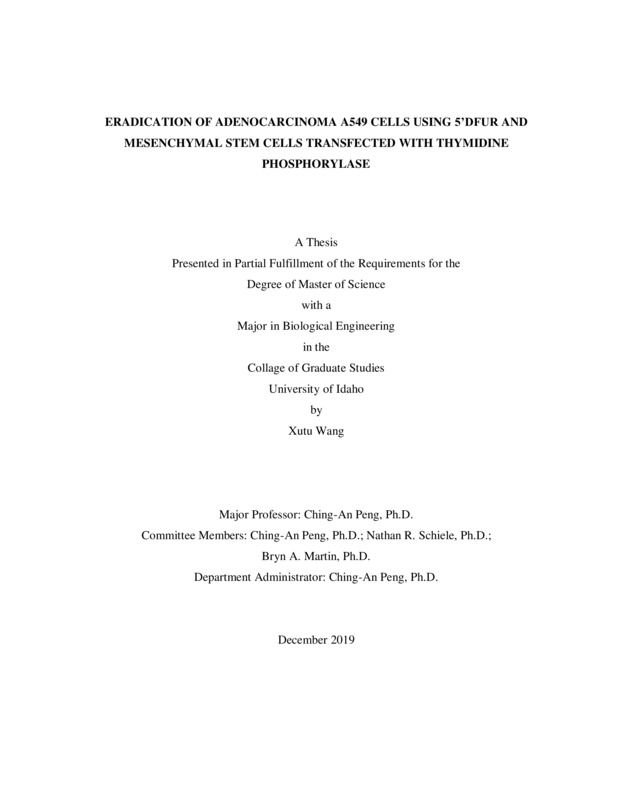ERADICATION OF ADENOCARCINOMA A549 CELLS USING 5’DFUR AND MESENCHYMAL STEM CELLS TRANSFECTED WITH THYMIDINE PHOSPHORYLASE
Wang, Xutu. (2019-12). ERADICATION OF ADENOCARCINOMA A549 CELLS USING 5’DFUR AND MESENCHYMAL STEM CELLS TRANSFECTED WITH THYMIDINE PHOSPHORYLASE. Theses and Dissertations Collection, University of Idaho Library Digital Collections. https://www.lib.uidaho.edu/digital/etd/items/wang_idaho_0089n_11714.html
- Title:
- ERADICATION OF ADENOCARCINOMA A549 CELLS USING 5’DFUR AND MESENCHYMAL STEM CELLS TRANSFECTED WITH THYMIDINE PHOSPHORYLASE
- Author:
- Wang, Xutu
- Date:
- 2019-12
- Embargo Remove Date:
- 2021-07-02
- Keywords:
- 5'DFUR A549 cells human mesenchymal stem cells Thymidine phosphorylase
- Program:
- Biological & Agricultural Engineering
- Subject Category:
- Bioengineering
- Abstract:
-
Chemotherapy drugs have been widely used for many years in cancer therapy, but produce horrible side effects like low blood cell count, nausea, and hair loss. Targeting cancer cells with a non-toxic prodrug, which is then converted to a chemotherapy drug in the vicinity of targeted cells, can largely reduce the side effects of chemotherapy. Gene-directed enzyme prodrug therapy (GDEPT) has been in development for more than 20 years as a cancer therapy approach to more effectively target tumor cells and reduce toxicity to healthy cells. Various GDEPT systems have advanced into clinical trials yet no GDEPT drug in the market indicating there are still barriers to overcome. GDEPT mainly consists of three parts to achieve the treatment: a nontoxic prodrug, a gene encoded for the enzyme which can convert the prodrug to toxicity drug, and a gene carrier. In this study, we used a well-known chemotherapy drug fluorouracil (5-FU) and its prodrug 5’DFUR, an enzyme called thymidine phosphorylase (TP), and human mesenchymal stem cells (human MSCs) as the gene carrier. A non-viral vector should be very safe for gene delivery when compared to a viral vector. One problem of using non-viral vectors (e.g., polyethylenimine) was the delivery efficiency of TP gene to human MSCs is extremely low. Since a viral vector has a much higher delivery efficiency than a non-viral vector, the viral vector containing TP gene was constructed for human MSCs gene delivery and resulted in very high delivery efficiency and subsequent protein expression. The TP gene was first delivered into A549 cells to test the cancer cell viability with 5’DFUR prodrug treatment. The TP enzyme-prodrug conversion rate in A549 cells was quantified by enzymatic assays. TP was overexpressed in A549 cells after gene delivery and converted 5’DFUR to 5-FU at a high rate, resulting in elimination of 90% of A549 cells in 4 days. Next, human MSCs infected by TP-encoded lentiviral vectors were co-cultured with A549 cells to test cell viability of both A549 cells and human MSCs after treated with prodrug 5’DFUR. Cell viability decreased to 10% in 5 days after the prodrug was administered. In summary, this study shows that prodrug 5’DFUR can be converted to chemotherapy drug 5-FU by TP-expressing human MSCs at a high rate, and results in elimination of both cancer cells and carrier cells in a short time frame.
- Description:
- masters, M.S., Biological & Agricultural Engineering -- University of Idaho - College of Graduate Studies, 2019-12
- Major Professor:
- Peng, Chin-An
- Committee:
- Peng, Ching-An ; Schiele, Nathan ; Martin, Bryn
- Defense Date:
- 2019-12
- Identifier:
- Wang_idaho_0089N_11714
- Type:
- Text
- Format Original:
- Format:
- application/pdf
- Rights:
- In Copyright - Educational Use Permitted. For more information, please contact University of Idaho Library Special Collections and Archives Department at libspec@uidaho.edu.
- Standardized Rights:
- http://rightsstatements.org/vocab/InC-EDU/1.0/

